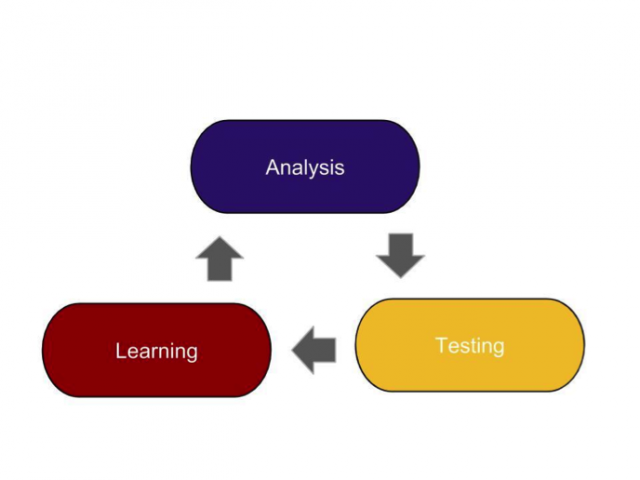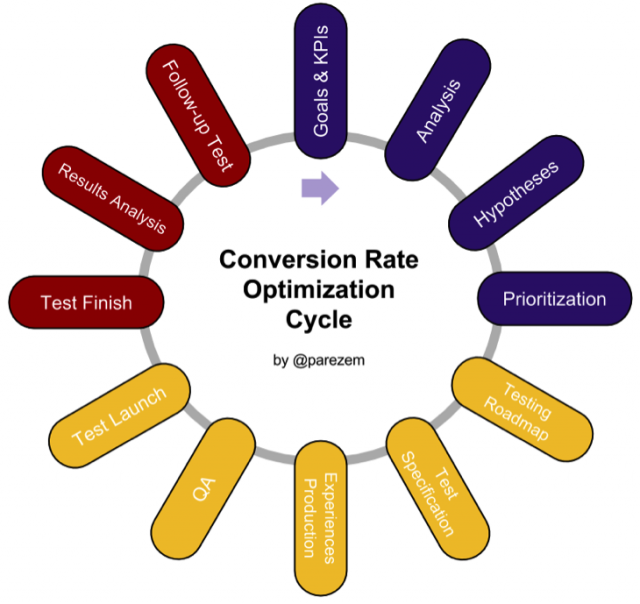When you start your Conversion Rate Optimization (CRO) journey you most probably do it chaotically. Unfortunately, the absence of regular processes results in poor results and in longer optimization cycles.
A good methodology guides you through crucial steps, which eventually lead to more successes or allow you to do more with less.
In this article I would like to share a few tips on how to run a CRO program more smoothly and with better results. It may help you to overcome your bottlenecks or just inspire you to add some new deliverables. The article is part of the Conversion Rate Optimization Maturity Model series.
The Basics
I believe Conversion Rate Optimization should consist of three main processes, creating what I call the Optimization circle:

Here is a brief description of the process:
- Analysis: You should always start with an analysis, it will help you monitor the website performance, find weak spots and uncover potential improvements. Seek for insights and finalize all your analyses with tangible recommendations. Then transform those recommendations into testing ideas. This is the most challenging step
- Testing: Prioritize your testing ideas and start working on the best ones, one at a time. Create mockups, validate them, and outline a testing roadmap for at least a few weeks. Share it with key stakeholders so everyone is aware of the timing and deliverables needed to get the tests done on time.
- Learning: Learn from every test, regardless of the result. First, decide who the winner is (if there is any) and then think about the conclusions and next steps. What do the results tell you? Can you do a follow-up test? Very often a “failed” test shows you a different direction worth exploring. And don’t forget to communicate the learnings across the key stakeholders and possibly wider audience!
As you can see in the diagram above, CRO is a neverending cycle. Right after the Learning part you deep dive again into an Analysis – does the full-scale test had the impact it promised to deliver? What else should we improve now? Where should we focus next?
That is the fundamental optimization circle in a nutshell. You should always perform CRO with the three key processes in mind. If you skip the Analysis part, it is as if you are throwing a pea against the wall and seeing which one sticks. If you skip Testing part you will never know if your hypotheses are valid. If you skip Learning part your testing program (and ultimately your business) won’t get any better.
An obsessive focus on CRO processes will help you reach better results
Ultimately there two main ways to succeed with Conversion Rate Optimization: focusing on quality or quantity of A/B tests. Which one is better? Both – a lot of high-quality A/B tests! Strive to increase the quantity of A/B tests in a given time and work hard to get the best insights from each one to help transforming followup A/B tests into more effective and successful ones. Below are some techniques to help you do just that.
A/B Tests Quality
Occasionally you can be lucky and execute a high-impact test out of nowhere, but in most cases there are necessary steps to follow in order to get substantial results in a long term period.

- Goals and KPIs: Identify your business and website goals, assign Key Performance Indicators to each of them.
- Thorough analysis: Analyze both quantitative and qualitative data: web analytics, surveys, screen recordings, cohorts, usability testing, mystery shopping, heatmaps etc. What are the conclusions and tangible next steps coming from your analysis?
- Hypotheses: Transform the recommendation into valid hypotheses which you are going to evaluate.
- Prioritization: Sort your hypotheses in terms of potential impact and estimated effort. Pick the low-effort and high-impact ones first and move forward.
- Testing roadmap: Set up a plan of your A/B tests and other CRO initiatives, make sure the timings are realistic. Leave at least two weeks for each test, especially if you don’t have a high traffic website. Don’t plan two tests to run at the same time at the same location, tests can influence each other.
- Test specification: Describe every A/B test in detail: start with your hypothesis supported by the analysis, specify all details, and add final designs plus copies. When it is done, send to production.
- Experiences production: Cooperate with developers on creating desired testing experiences, pro-actively.
- QA: Make sure the testing experiences are running smoothly in all main browsers and all preferably all devices.
- Test launch: Set up the A/B test in your tool, define all necessary goals and targeting rules (if needed); you are almost ready to go. Before launching the test verify the goals are tracked properly and the A/B test logic works fine.
- Test finish: Take enough time to finalize the test, be patient! Be impartial, analyze the results thoroughly, use segmentation.
- Results: What did the test results tell you? How can you and your colleagues learn from it? Decide your next steps: full-scale the winner, test the idea in other market or execute a re-test?
- Follow-up test: Do the results show you an interesting idea worth exploring? If so, go for it! Prepare a follow-up test and dive deeper.
As I mentioned earlier Conversion Rate Optimization is a never ending cycle, so after finishing one circle, immediately start another.
A/B Tests Quantity
A high quantity of A/B tests requires a flexible organization and enough resources. Also, your organization must embrace A/B testing and give it necessary attention. It is difficult to get things done fast enough if you don’t have support from management.
A few things I would like to emphasize in order to get as much A/B tests as possible.
- Strong relationship with developers and operation resources: It is crucial to have a close bond to your execution team, production is a usual bottleneck and enough resources together with good communication can speed this up. A few tips to improve your relationship:
- Share the same boss: it so much easier when CRO marketers and developers share the same boss. From allocating resources to prioritization to sharing the same goals.
- Organize weekly/daily stand-up meetings: get a timeslot together to agree on priorities and plan activities ahead.
- Be helpful: If there is something you can do to take some load off your developers, do that. A) You might get that work done faster by sharing workload. B) You show them a sense of cooperation which makes your relationship stronger.
- Flexible CMS and E-Commerce platform: Conversion Rate Optimization often requires code changes: implementing tools, setting up tests, applying test results. Your platforms need to allow that and be flexible enough to make the desired changes smoothly and quickly.
- Everyone in the loop: Keep every key stakeholder involved about optimization agenda, timings, and necessary deliverables. If everyone knows what needs to be done and when, things get done faster.
- Thoughtful planning: Make a plan for weeks ahead with timings and deliverables, and educate your team to stick to that. I mentioned planning earlier in the “Quality” section (because it is an essential step) but it mostly influences the quality of your tests.
- Getting results soon: All the tips I shared with you so far in this “Quantity” section focused on diminishing the time to launch an A/B test. But it is also essential you don’t have a test running longer than it is necessary. Always test your ideas at pages or markets where you have the highest traffic and conversions so you can get the results soon.
Closing Thoughts
That would be my two cents in the topic of the importance of CRO processes. I strongly believe that they have a crucial impact on the bottom line. Great processes lead to higher quality tests and to increased quantity. Therefore it influences both factors to get better optimization results.
What is your way of organizing Conversion Rate Optimization? What are your key processes and what would be your suggestions on how to improve the way we execute CRO?








